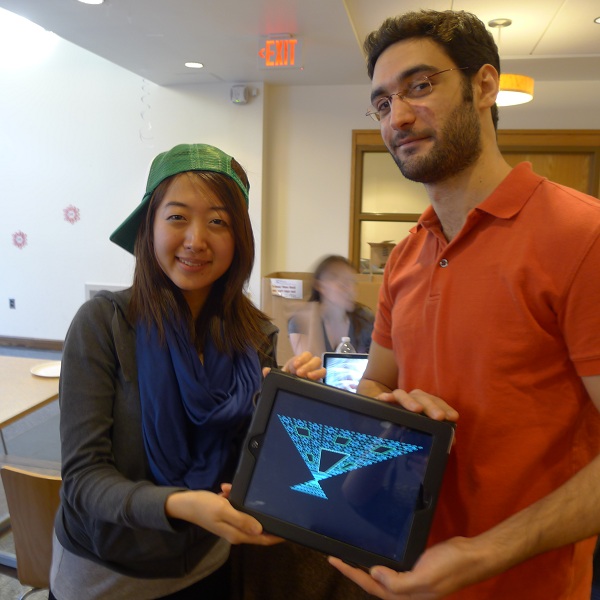
As a hackathon community in Philadelphia has grown in the last five years, there has been growing interest in keeping projects alive after they launch.
Take a look here at all the hackathons planned for 2013. After programmers and the ideas for software, applications, data tools and other technologies come alive during one of those time-crunched events, what do you do next?
The organizers of PennApps, called one of the world’s largest undergraduate hackathons in the world, followed up their January event this weekend with what is becoming a common second act: a Finish-athon. The idea is that the energy of a hackthon is well-suited at hacking together small, creative solutions, but not for making projects ready for launch. So organize a follow-up event that is focused on getting those projects closer to being used.

Hosted this weekend in McClelland South Lounge of the University of Pennsylvania’s Ware College House dorm, the event ran from noon to 7:30 p.m., when teams were scheduled to demo progress on their projects. Both the PennApps Hackathon and Finishathon are run by the student organization, the Dining Philosophers, which plans to host a Finishathon every semester following the recurring Hackathon.
“In class, you learn a lot of theory. Here, you can put it into practice,” said Ayaka Nonaka, the head of the Dining Philosophers’ hacking committee — she was also a participating member in the finishathon.
Lane Rettig, an MBA candidate and former software developer, worked both events as a mentor and while he found the Finishathon to be “a lot more laid back,” he said he saw it and the hackathon as “fundamentally the same thing.” At both events, he was impressed by the students’ passion and dedication and found himself benefiting from the exchange of ideas.
“This is, hands down, an awesome experience,” he said.
Here are some of the highlights from the PennApps Finishathon:
- GreenVote. Have you ever sat in a meeting, dying of heat, or did you ever cuddle up to a classmate in a freezing cold lecture hall? Benedikt Lotter, Karan Hirenath and Arjun Jain – all freshman at Penn – have been there. And they realized that there’s no way for building managers to know how people are feeling and that a lot of money is spent on inefficient heating and cooling. In order to pass on savings to companies and institutions, these three students have developed an app that would allow users to select the building and room they are in and indicate whether it is too hot or too cold. They are planning to test the app on Penn’s campus within the next two weeks. They’ve also written a business plan that they’re submitting to business plan competitions. In addition, they’re considering ways to connect with other existing companies such as Shop Your Way and provide savings to the customers who take the time to give companies feedback about their environment. “We’re always looking at ways to incentivize our customers,” Hirenath said.
- Penn Projects. Ian Sibner, Tom Shen, Doron Shapiro and Vivian Huang have created a website to showcase the various projects created by other students at Penn. The students submit their own projects to the site with links to a website and photos. Then anyone with an interest in what Penn’s young talents are up to can browse the various projects. “We hope it will help Penn students get the word out and help others get a feel for what Penn students are up to,” Sibner said.
- The Art of Recursion. This phone app is pure fun. Based on the math learned in a class called the Art of Recursion, three students (Mishal Awadah, Elissa Wolf and Nonaka) created an app that draws recursive patterns like the Sierpinski triangle and Sierpinski carpet that vary based on the number of fingers you apply to the iPad screen. You can use up to six fingers to draw these shapes. The app will soon be available on the iTunes app store.
- Doortags. Student Daniel Ge was a little disappointed to discover that the dorms didn’t have doorbells. Now, he’s created a system that would work in place of a doorbell or the wipe-erase boards that lots of students put on their dorm room doors. Students (or homeowners) can purchase NFC tags for roughly $1 per tag. The NFC tag has a microchip that can store a small amount of data – like a “Missed You” message. With the app he’s developed, a would-be guest can read the NFC tag and leave a message, which is then transferred to the intended recipient via text message. He envisions delivery companies such as UPS using the technology to leave messages for package recipients who aren’t home. “There are glaring security issues,” Ge said of the app, which he said wouldn’t be flawless by the end of Finishathon. He plans instead to introduce the technology at the next general floor meeting in his dorm.
You can learn more about PennApps here.
This report was done in partnership with Temple University’s Philadelphia Neighborhoods program, the capstone class for the Temple’s Department of Journalism.







